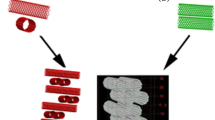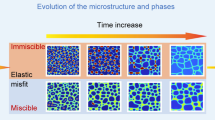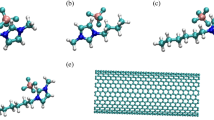Abstract
This study investigated influences of vacancy defects on buckling behaviors of open-tip carbon nanocones (CNCs) by molecular dynamics simulations. Effects of vacancy location and temperature on the buckling behaviors were examined in the study. Some interesting findings were attained from the investigations. It was noticed that the CNC with an upper vacancy has comparable degradation in the critical strain and in the critical load with the CNC with a middle vacancy, whereas the CNC with a lower vacancy has lower degradation in the antibuckling ability than the above two CNCs. The antibuckling ability of the CNCs reduces with the growth of the temperature. This temperature effect is more apparent in the perfect CNC than in the vacancy-defect CNCs. It was also observed that the degradation in the antibuckling ability is obvious at a lower temperature, but it decreases as the temperature grows. Besides, all the CNCs (including the perfect and the vacancy-defect CNCs) exhibited a shrinking/swelling buckling mode shape at the studied temperatures. Existence of the vacancies did not alter the buckling mode shape of the CNCs.








Similar content being viewed by others
References
N. Tagmatarchis ed.: Advances in Carbon Nanomaterials: Science and Applications (Pan Stanford Publishing, Singapore, 2012).
M. Ge and K. Sattler: Observation of fullerene cones. Chem. Phys. Lett. 220, 192–196 (1994).
A. Krishnan, E. Dujardin, M.M.J. Treacy, J. Hugdhl, S. Lynum, and T.W. Ebbesen: Graphitic cones and the nucleation of curved carbon surfaces. Nature 388, 451–454 (1997).
S.N. Naess, A. Elgsaeter, G. Helgesen, and K.D. Knudsen: Carbon nanocones: Wall structure and morphology. Sci. Technol. Adv. Mater. 10, 065002 (2009).
S. Iijima, M. Yudasaka, R. Yamada, S. Bandow, K. Suenaga, F. Kokai, and K. Taskahashi: Nanoaggregates of single-walled graphitic carbon nanohorns. Chem. Phys. Lett. 309, 165–170 (1999).
Y. Gogotsi, S. Dimovski, and J.A. Libera: Conical crystals of graphite. Carbon 40, 2263–2267 (2002).
G. Zhang, X. Jiang, and E. Wang: Tubular graphite cones. Science 300, 472–474 (2003).
Z.L. Tsakadze, I. Levchenko, K. Ostrikov, and X. Su: Plasma-assisted self-organized growth of uniform carbon nanocone arrays. Carbon 45, 2022–2030 (2007).
I. Levchenko, K. Ostrikov, J.D. Long, and S. Xu: Plasma-assisted self-sharpening of platelet-structured single-crystalline carbon nanocones. Appl. Phys. Lett. 91, 113115 (2007).
H. Terrones, T. Hayashi, M. Muñoz-Navia, M. Terrones, Y.A. Kim, N. Grobert, R. Kamalakaran, J. Dorantes-Davila, R. Escudero, M.S. Dresselhaus, and M. Endo: Graphitic cones in palladium catalysed carbon nanofibers. Chem. Phys. Lett. 343, 241–250 (2001).
M. Endo, Y.A. Kim, T. Hayashi, Y. Fukai, K. Oshida, M. Terrones, T. Yanagisawa, S. Higaki, and M.S. Dresselhaus: Structural characterization of cup-stacked-type nanofibers with an entirely hollow core. Appl. Phys. Lett. 80, 1267 (2002).
B. Ekşioğlu and A. Nadarajah: Structural analysis of conical carbon nanofibers. Carbon 44, 360–373 (2006).
I.C. Chen, L.H. Chen, A. Gapin, S. Jin, L. Yuan, and S.H. Liou: Iron-platinum-coated carbon nanocone probes on tipless cantilevers for high resolution magnetic force imaging. Nanotechnology 19, 075501 (2008).
J. Sripirom, S. Noor, U. Koehler, and A. Schulte: Easily made and handled carbon nanocones for scanning tunneling microscopy and electroanalysis. Carbon 49, 2402–2412 (2011).
J.Y. Hsieh, C. Chen, J.L. Chen, C.I. Chen, and C.C. Hwang: The nanoindentation of a copper substrate by single-walled carbon nanocone tips: A molecular dynamics study. Nanotechnology 20, 095709 (2009).
S.S. Yu and W.T. Zheng: Effect of N/B doping on the electronic and field emission properties for carbon nanotubes, carbon nanocones, and graphene nanoribbons. Nanoscale 2, 1069–1082 (2010).
O.O. Adisa, B.J. Cox, and J.M. Hill: Open carbon nanocones as candidates for gas storage. J. Phys. Chem. C 115, 24528–24533 (2011).
M.L. Liao: A study on hydrogen adsorption behaviors of open-tip carbon nanocones. J. Nanopart. Res. 14, 837 (2012).
N. Yang, G. Zhang, and B. Li: Carbon nanocone: A promising thermal rectifier. Appl. Phys. Lett. 93, 243111 (2008).
S.P. Jordan and V.H. Crespi: Theory of carbon nanocones: Mechanical chiral inversion of a micron-scale three-dimensional object. Phys. Rev. Lett. 93, 255504 (2004).
P.C. Tsai and T.H. Fang: A molecular dynamics study of the nucleation, thermal stability and nanomechanics of carbon nanocones. Nanotechnology 18, 105702 (2007).
K.M. Liew, J.X. Wei, and X.Q. He: Carbon nanocones under compression: Buckling and post-buckling behaviors. Phys. Rev. B 75, 195435 (2007).
J.X. Wei, K.M. Liew, and X.Q. He: Mechanical properties of carbon nanocones. Appl. Phys. Lett. 91, 261906 (2007).
M.L. Liao, C.H. Cheng, and Y.P. Lin: Tensile and compressive behaviors of open-tip carbon nanocones under axial strains. J. Mater. Res. 26, 1577–1584 (2011).
M.M.S. Fakhrabadi, N. Khani, R. Omidvar, and A. Rastgoo: Investigation of elastic and buckling properties of carbon nanocones using molecular mechanics approach. Comput. Mater. Sci. 61, 248–256 (2012).
M.M.S. Fakhrabadi, B. Dadashzadeh, V. Norouzifard, and A. Allahverdizadeh: Application of molecular dynamics in mechanical characterization of carbon nanocones. J. Comput. Theor. Nanosci. 10, 1921–1927 (2013).
J.W. Yan, K.M. Liew, and L.H. He: A mesh-free computational framework for predicting buckling behaviors of single-walled carbon nanocones under axial compression based on the moving kriging interpolation. Comput. Methods Appl. Mech. Eng. 247, 103–112 (2012).
J.W. Yan, K.M. Liew, and L.H. He: Buckling and post-buckling of single-wall carbon nanocones upon bending. Compos. Struct. 106, 793–798 (2013).
M.L. Liao: Buckling behaviors of open-tip carbon nanocones at elevated temperatures. Appl. Phys. A 117, 1109–1118 (2014).
R. Andrews, D. Jacques, D. Qian, and E.C. Dickey: Purification and structural annealing of multiwalled carbon nanotubes at graphitization temperatures. Carbon 39, 1681–1687 (2001).
N. Pierard, A. Fonseca, Z. Konya, I. Willems, G. Van Tendeloo, and J.B. Nagy: Production of short carbon nanotubes with open tips by ball milling. Chem. Phys. Lett. 335, 1–8 (2001).
B. Ni and S.B. Sinnott: Chemical functionalization of carbon nanotubes through energetic radical collisions. Phys. Rev. B 61, R16343 (2000).
C.A. Cooper, S.R. Cohen, A.H. Barber, and H.D. Wagner: Detachment of nanotubes from a polymer matrix. Appl. Phys. Lett. 81, 3873–3875 (2002).
M. Sammalkorpi, A. Krasheninnikov, A. Kuronen, K. Nordlund, and K. Kaski: Mechanical properties of carbon nanotubes with vacancies and related defects. Phys. Rev. B 70, 245416 (2004).
H. Xin, Q. Han, and X.H. Yao: Buckling and axially compressive properties of perfect and defective single-walled carbon nanotubes. Carbon 45, 2486–2495 (2007).
M. Eftekhari, S. Mohammadi, and A.R. Khoei: Effect of defects on the local shell buckling and post-buckling behavior of single and multi-walled carbon nanotubes. Comput. Mater. Sci. 79, 736–744 (2013).
S. Sharma, R. Chandra, P. Kumar, and N. Kumar: Effect of Stone-Wales and vacancy defects on elastic moduli of carbon nanotubes and their composites using molecular dynamics simulation. Comput. Mater. Sci. 86, 1–8 (2014).
J. Tersoff: New empirical model for the structural properties of silicon. Phys. Rev. Lett. 56, 632–635 (1986).
J. Tersoff: Modeling solid-state chemistry: Interatomic potentials for multi-component systems. Phys. Rev. B 39, 5566–5568 (1989).
D.C. Rapaport: The Art of Molecular Dynamics Simulations (Cambridge University Press, Cambridge, 2004).
J.M. Haile: Molecular Dynamics Simulation: Elementary Method (John Wiley & Sons, New York, 1997).
ACKNOWLEDGMENTS
The author gratefully acknowledges the support provided to this research by the Ministry of Science and Technology of Taiwan under Project Grant No. NSC 103-2923-E-006-004-MY3. The author also thanks the editor and referees for their helpful recommendations to make this study more readable.
Author information
Authors and Affiliations
Corresponding author
Rights and permissions
About this article
Cite this article
Liao, ML. Influences of vacancy defects on buckling behaviors of open-tip carbon nanocones. Journal of Materials Research 30, 896–903 (2015). https://doi.org/10.1557/jmr.2015.60
Received:
Accepted:
Published:
Issue Date:
DOI: https://doi.org/10.1557/jmr.2015.60




